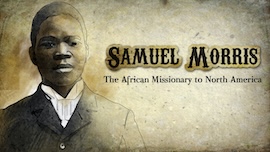Sammy Morris Pursued the LIGHT

[Above: Sammy Morris—Jorge O. Masa, The Angel in Ebony. Taylor University Press, 1928.]
HELD AS A HOSTAGE, Prince Kaboo was beaten daily because his father, a tribal king in Western Africa, could not provide sufficient ransom. The pain was so unbearable, Kaboo desired only to die. Yet he escaped.
A sudden light shone from the sky, the rope binding him fell off, and a voice told him to run. He fled into the jungle, eluded his pursuers, and made his way westward. Days later, he reached a coffee plantation where he encountered Christian teaching.
One day Miss Anna Knolls taught on the conversion of Paul when light shone from the sky. Kaboo shouted, “That’s just what I saw; that was what brought me here and saved me from my oppressors.” He became a dedicated Christian, often praying late into the night.
At Kaboo’s baptism in the late 1880s, Miss Knolls renamed the young man Samuel Morris in honor of a philanthropist who had sponsored her education at Fort Wayne College (Taylor University).
After two years of working on the plantation, Morris moved to Monrovia, Liberia, to learn more from the missionaries there. He painted houses and prayed. In his heart was growing the desire to lead his own people, the Kru of Liberia, to Christ.
One missionary, C. E. Smirl told him that if he wished to preach to the Kru, he needed an education. He would have to go to America. Another missionary, Lizzie McNeil, taught Morris everything she knew about the Holy Spirit. Morris hungered to learn more. When she said there was nothing else she could teach him, he asked, “Who taught you about the Holy Spirit?”
“Stephen Merritt,” she replied. Morris questioned her. Who was this Merritt? Where did he live? Satisfied with her answers, he said goodbye. Without money or a map of New York City, Morris prayed for a way to America and walked to the coast where he found a ship berthed. The brutal captain agreed to let him work his passage but Morris paid a heavy price in abuse. Still, the captain and most of the crew became Christians under Morris’s witness.
When Morris finally arrived in New York in 1891, he had no idea where to go. Merritt lived several miles from the dock. By “coincidence” one of the first people Morris met was an alcoholic who had once been assisted in one of Merritt’s shelters.
The man led Sammy to the St. James Street Methodist Episcopal Church where Merritt served as pastor. Merritt was heading off to a prayer meeting and sent Morris next door to a rescue mission for the evening. Afterwards he drove back to the mission and found seventeen men kneeling around the African, who had led them to Christ. That night, to the surprise of his wife, Dolly, Merritt took Morris into his home and put him up in the bishop’s room. Morris was the first Black man who ever ate at Merritt’s table. Much of what we know about Morris and his fervor for Christ was recorded by Merritt.
He told this story on himself. “I took him (Morris) in a coach with a prancing team of horses, as I was going to Harlem to officiate at a funeral. I said: ‘Samuel, I would like to show you something of our city and Central Park.’” Merritt showed Morris the sights. Suddenly Morris asked, “Stephen Merritt, do you ever pray in a coach?” Merritt assured him he did.
Morris placed his great hand on Merritt’s,
...and, turning me around on my knees, said: “We will pray,” and for the first time I knelt in a coach to pray. He told the Holy Spirit he had come from Africa to talk to me about Him, and I talked about everything else, and wanted to show him the church, and the city, and the people, when he was so desirous of hearing and knowing about Him; and he asked Him if He would not take out of my heart things, and so fill me with Himself, that I would never speak or write or preach or talk, only of Him. There were three of us in that coach that day. Never have I known such a day. We were filled with the Holy Spirit, and He made him the channel by which I became instructed and then endued as never before.
Sammy Morris’s presence led to a revival at Taylor University, which was then in dire financial straits. Soon the school’s finances improved. However, the young man did not long survive the cold weather in Indiana and died on 12 May 1893. On this day, 20 May 1928, Taylor students replaced his simple gravestone with a monument.
—Dan Graves
----- ----- -----
Learn more about Morris in Samuel Morris: The African Missionary to North America. Watch at RedeemTV.

You can purchase Samuel Morris at Vision Video.
Other Events on this Day
- The Chalmers Arrived at Rarotonga Aboard a Pirate Ship
- MICHAEL SATTLER DEFENDED HIS ANABAPTIST FAITH TO THE END






